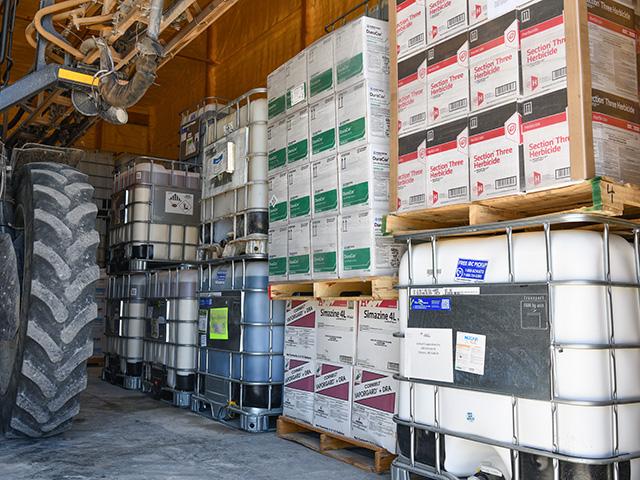Avoid Overwinter Woes in Chemical Shed
Four Things to Remember When Storing Pesticides Between Growing Seasons
JEFFERSON CITY, Mo. (DTN) -- Is your chemical shed empty right now? Most row-crop farmers would answer "no." While some growers are carrying over unused pesticides from 2022, others have already purchased some chemistry ahead for 2023.
Whether left over or brand new, storing these products over the winter isn't completely without risk. Like other goods, pesticides and their accompanying adjuvants have expiration dates and shelf lives, both of which can be greatly affected by storage conditions.
"Farmers often have tens of thousands of dollars tied up in crop-protection products sitting in the shed, so it's important they do all they can to protect that investment," said Fred Whitford, director of Purdue Pesticide Programs. "Taking a few simple steps can help make sure farmers get their money's worth from these products."
Here's a quick rundown of four things farmers should keep in mind when storing pesticides over the winter:
1. Don't Overlook the Label.
Pesticide storage requirements can vary widely. Some products can freeze; others can't. Some can handle extreme heat while others need to be stored within a certain temperature range. Some must be kept out of direct sunlight. Reading the label will shed the proverbial light on proper storage conditions for a particular pesticide. More details on the temperature limitations of most pesticides can be found here: https://extension.missouri.edu/….
"Understanding how freezing and thawing impacts a product's efficaciousness is especially important," Whitford said. "Sometimes, once a product freezes, ingredients settle out and you can't get them mixed back into solution again."
P[L1] D[0x0] M[300x250] OOP[F] ADUNIT[] T[]
Once growers determine the storage requirements for the pesticides they use, they should find a storage location to match them. Ideally, dry formulations should be stored in a low-moisture environment to avoid issues with clumping. It's also best to store dry products on shelves above liquid ones. Additional information on pesticide storage can be found here: https://extension.psu.edu/….
2. Out With the Old First.
Under the Federal Insecticide, Fungicide and Rodenticide Act (FIFRA), the EPA requires all pesticide products to meet active ingredient stability and product quality specifications. Whitford said that for most products, the formulation must remain stable for two to three years under normal conditions.
"That doesn't mean that after three years, a product isn't good anymore," he said, likening it to the "best by" dates food manufacturers use. "They stamp your gallon of milk with a date, but that doesn't mean the milk goes bad on that date. Same with these pesticides. One product may be four or five years old and still as effective as when it was purchased, but another may lose its efficacy faster. Every pesticide is different."
A permanent marker is all a farmer needs to keep track of how long a chemical has been in inventory. Write the purchase date on each container or on the box in which they are packed. It's also good to note when products are opened if they aren't completely used during the season.
"Oxygen can reduce shelf life, so you want to use up those open products first," Whitford said. "Move the open and older product to the front and put the new product in the back. It sounds basic, but simple inventory management makes a difference."
3. Assess Your Adjuvants.
Many of today's herbicides, insecticides and fungicides require some type of adjuvant to maximize their efficacy. These products -- from surfactants and crop oils to anti-foaming materials and other buffering and compatibility agents -- also can lose their effectiveness with time on the shelf.
Whitford likened it to baking a cake: If you're using old baking powder, for example, the cake may not rise as much as if you had used new baking powder. Similarly, you may lose some pest control the longer your adjuvants sit around.
"You need to make sure you're rotating your stock to ensure those products perform as intended, too," he said.
4. Get Agitated.
After sitting for months in the chemical shed, some products may separate in their containers, lessening their efficacy. Whitford said it's important to shake things up when spring arrives.
"You want to make sure any solvents or other inert ingredients are blended back in with the active ingredient," he said. "If the product is in a smaller jug, shake it back and forth for a couple minutes before adding to your sprayer tank. If it's in a mini-bulk container, you can mix it in the container or transfer it to another one to make sure all ingredients are incorporated."
See more from Purdue University on how long your pesticide can last here: https://ppp.purdue.edu/….
Jason Jenkins can be reached at jason.jenkins@dtn.com
Follow him on Twitter @JasonJenkinsDTN
(c) Copyright 2022 DTN, LLC. All rights reserved.






